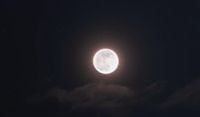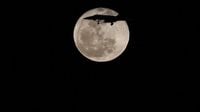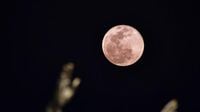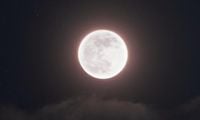Skywatchers across India are gearing up for a celestial spectacle as the enchanting Pink Moon is set to grace the night sky on April 12, 2025. This full moon, peaking in the early hours of Sunday, April 13, at 5:00 AM IST, promises to be a beautiful sight visible from homes, balconies, and rooftops. However, don’t let the name fool you—the moon won’t actually turn pink.
The term "Pink Moon" comes not from the moon’s color, but from seasonal traditions that date back centuries. According to India Today, Native American and European cultures used full moons to mark time and signal seasonal changes. April’s full moon coincides with the bloom of wild pink phlox, one of the first flowers to blossom in spring, hence the name.
This year, the Pink Moon will also be a micro moon, meaning it will appear slightly smaller and dimmer than usual, as it reaches its full phase when it's farthest from Earth in its orbit. The moon, which will rise in the east just after sunset on April 12, will create a striking visual effect known as the "moon illusion," making it appear larger near the horizon, especially when atmospheric conditions add a soft orange glow.
For those looking to catch this celestial event, the best viewing spots include urban viewpoints like tall buildings or open rooftops with a clear view of the eastern sky, rural escapes that offer darker skies away from light pollution, and coastal scenes such as beaches or cliffs with open horizons that provide uninterrupted moonrise views.
In addition to the Pink Moon, April 12, 2025, holds great significance as it coincides with Hanuman Jayanti, a festival celebrating the birth of Lord Hanuman. This year, the festival falls on a Saturday, which is particularly auspicious. Hanuman is considered an incarnation of Rudra, and his birth is said to have originated from the 'Chaitanya' element, known in scientific terms as cosmic consciousness.
According to ancient scriptures, the full moon is a time when mental and spiritual energies peak. Thus, Hanuman Jayanti falling on a full moon day radiates extraordinary spiritual energy. Worshipping Hanuman on a Saturday is believed to help remove the ill effects of Shani dosha, Sade Sati, and negative energies, creating a rare and powerful alignment.
Astrologically, this day is further enhanced by the formation of a rare Panch Grahi Yoga in the zodiac sign Pisces, with Jupiter positioned there. This unique alignment will witness the conjunction of Saturn, Mercury, Venus, Sun, and Rahu in Pisces, signifying public awareness and significant changes.
On the same day, the moon will be in Virgo, forming a conjunction with the malefic planet, creating an optimal yoga for emotional analysis and devotion. This is why spiritual practices, mantra chanting, and meditation performed on Hanuman Jayanti will yield results far more powerful than usual.
Those participating in the celebrations are encouraged to engage in several remedies to harness the day’s spiritual energy. They include reciting Bajrang Baan in the morning, donating black sesame seeds to remove Shani and Pitru dosha, applying a tilak of red sandalwood to Lord Hanuman in the evening, chanting Hanuman Kavach 11 times at night, and offering water to the moon while meditating to purify the mind.
While the Pink Moon is a natural phenomenon, its occurrence on Hanuman Jayanti intertwines faith, science, and cosmic alignment, making April 12, 2025, a day of profound significance. The strength of Lord Hanuman, Saturn's discipline, the mental energy of the Moon, and the astrological alignments all point to this day as an opportunity to awaken spiritual power.
In the United States, the Pink Moon will also be visible on the evening of April 12, 2025, at around 8:22 PM EDT. Observers will witness both a micromoon and a pink moon at the same time, with the full moon appearing up to 14% smaller and 30% dimmer than a supermoon. NASA states that the micromoon occurs when the celestial body is at its farthest point from Earth, approximately 251,000 miles away.
Despite its name, the moon will not actually shine pink. The name "Pink Moon" is derived from the bloom of the creeping phlox flowers that occur in early spring. The tradition of calling the first full moon in April was introduced by some Native Americans, as it coincided with the blooming of this pinkish flower, signaling the onset of spring in North America.
As the Pink Moon rises on April 12, it invites both stargazers and devotees to reflect on the convergence of natural beauty and spiritual significance. Whether one is drawn to the night sky or the rich traditions surrounding Hanuman Jayanti, this day promises a unique blend of wonder and reverence.





